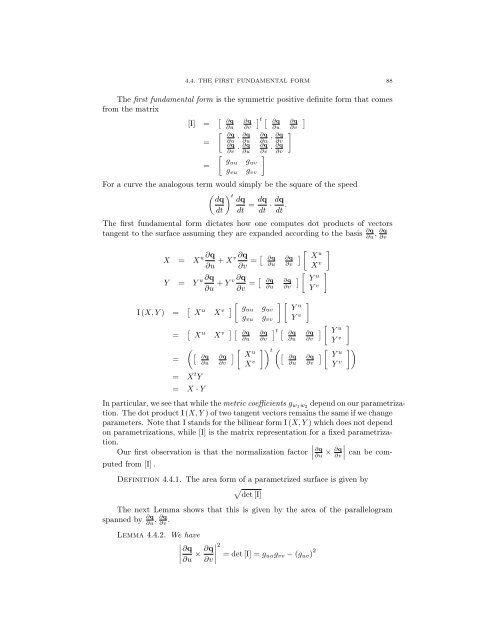Lecture Notes for 120 - UCLA Department of Mathematics
Lecture Notes for 120 - UCLA Department of Mathematics
Lecture Notes for 120 - UCLA Department of Mathematics
You also want an ePaper? Increase the reach of your titles
YUMPU automatically turns print PDFs into web optimized ePapers that Google loves.
4.4. THE FIRST FUNDAMENTAL FORM 88<br />
The first fundamental <strong>for</strong>m is the symmetric positive definite <strong>for</strong>m that comes<br />
from the matrix<br />
[I] = ⇥ ⇤<br />
@q t ⇥ @q<br />
⇤<br />
=<br />
=<br />
@q<br />
@u @v @u<br />
apple @q<br />
@u · @q @q<br />
@u @u · @q<br />
@v<br />
@q<br />
@v · @q @q<br />
@u @v · @q<br />
@v<br />
apple<br />
guu g uv<br />
g vu g vv<br />
For a curve the analogous term would simply be the square <strong>of</strong> the speed<br />
✓ ◆ t dq dq<br />
dt dt = dq<br />
dt · dq<br />
dt .<br />
The first fundamental <strong>for</strong>m dictates how one computes dot products <strong>of</strong> vectors<br />
tangent to the surface assuming they are expanded according to the basis @q<br />
@u , @q<br />
@v<br />
@q<br />
@v<br />
X = X u @q @q<br />
+ Xv<br />
@u @v = ⇥ @q<br />
@u<br />
Y = Y u @q<br />
@u + Y v @q<br />
@v = ⇥ @q<br />
@u<br />
@q<br />
@v<br />
@q<br />
@v<br />
⇤ apple X u<br />
X v<br />
⇤ apple Y u<br />
Y v<br />
I(X, Y ) = ⇥ X u X ⇤ apple apple v g uu g uv Y<br />
u<br />
g vu g vv Y v<br />
= ⇥ X u X v ⇤⇥ @q<br />
@u<br />
=<br />
✓ ⇥ @q<br />
@u<br />
= X t Y<br />
= X · Y<br />
@q<br />
@v<br />
⇤ apple X u<br />
X v<br />
@q<br />
@v<br />
⇤ t ⇥ @q<br />
@u<br />
◆ t ✓ ⇥ @q<br />
@u<br />
@q<br />
@v<br />
@q<br />
@v<br />
⇤ apple Y u<br />
Y v<br />
⇤ apple Y u<br />
In particular, we see that while the metric coefficients g w1w 2<br />
depend on our parametrization.<br />
The dot product I(X, Y ) <strong>of</strong> two tangent vectors remains the same if we change<br />
parameters. Note that I stands <strong>for</strong> the bilinear <strong>for</strong>m I(X, Y ) which does not depend<br />
on parametrizations, while [I] is the matrix representation <strong>for</strong> a fixed parametrization.<br />
Our first observation is that the normalization factor<br />
can be computed<br />
from [I] .<br />
Y v<br />
@q<br />
@u ⇥ @q<br />
@v<br />
Definition 4.4.1. The area <strong>for</strong>m <strong>of</strong> a parametrized surface is given by<br />
p<br />
det [I]<br />
◆<br />
The next Lemma shows that this is given by the area <strong>of</strong> the parallelogram<br />
spanned by @q<br />
@u , @q<br />
@v .<br />
Lemma 4.4.2. We have<br />
@q<br />
@u ⇥ @q<br />
@v<br />
2<br />
=det[I]=g uu g vv (g uv ) 2
















